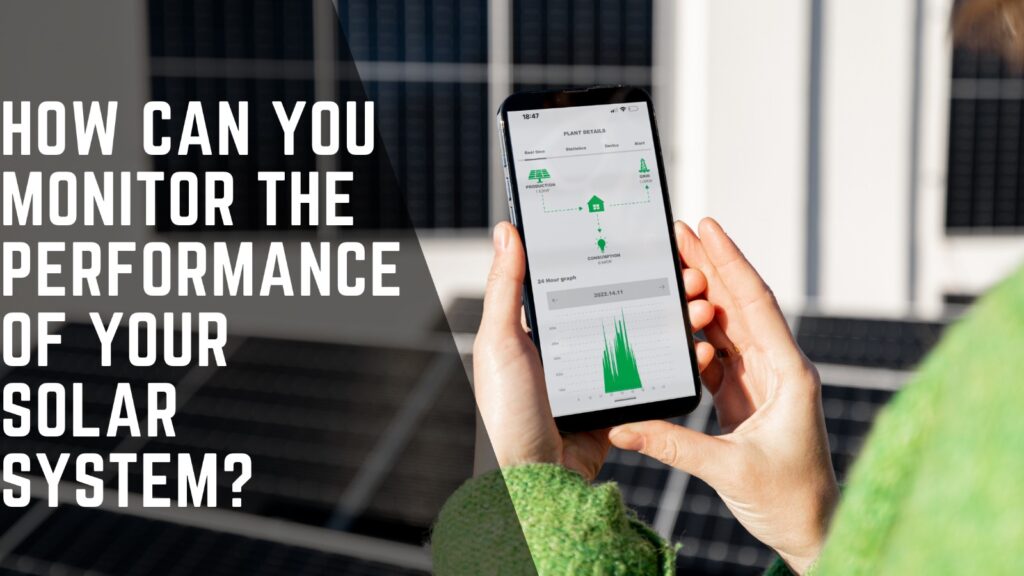Monitor Solar Power System Performance: Essential Tips and Tools
It’s essential to keep an eye on your solar power system’s performance to guarantee efficiency and maximize energy output. By closely monitoring your system, you may identify problems early and make the required corrections. This blog will walk you through the crucial pointers and resources required to efficiently monitor the functioning of a solar power installation.
Why Monitoring is Essential
Optimizing your solar power system’s efficiency requires monitoring. You can make sure your system is performing at its peak by monitoring performance metrics. Monitoring enables you to quickly recognize and resolve performance-related problems. You can rapidly identify the reason for any declines in performance and take appropriate action. Additionally, by making sure your solar panels are properly maintained, monitoring increases their lifespan.
Types of Monitoring Systems
Basic Monitoring Systems:
- Inverter Displays: The majority of solar power systems use inverters with integrated screens. Basic system performance data, like current energy generation and system status, is shown on these panels.
- Utility Meters: Utility meters measure the electricity generated by your solar panels and the amount returned to the grid. This helps you understand your net energy production and utilization.
Advanced Monitoring Systems:
- Online Monitoring Platforms: You may use any internet-connected device to remotely monitor the functioning of your solar power system in real time using these web-based applications. They can notify you of any problems and provide in-depth information.
- Mobile Apps: Complementary smartphone apps that offer the same real-time data and insights as internet platforms are often included with solar power systems. Using these programs, you can conveniently keep an eye on your system from a tablet or smartphone.
Comparison
Basic Systems: Offer vital information and are commonly found in the majority of solar power systems. They’re simple to use and comprehend.
Advanced Systems: Provide more in-depth information and tools, like performance alerts, remote monitoring, and historical data analysis. For users who would want greater control and insight into the operation of their system, they are perfect.
Key Performance Metrics to Track
Energy Production:
Total Energy Generated: Keep track of the total energy your system produces during a given time frame. This aids in your comprehension of the general effectiveness and performance of your system.
Energy Consumption:
Energy Used: Keep an eye on how much energy your home or place of business uses. You can manage your energy use and find areas to save money with the help of this information.
System Efficiency:
Efficiency Ratio: Calculate the energy output to solar energy intake ratio. This aids in your comprehension of how well sunshine is converted into useable electricity by your system.
Temperature:
Impact on Performance: Monitor your solar panels’ temperature diligently, as excessive heat can diminish their effectiveness. Monitoring temperature changes will enable you to maintain peak performance by taking preventative action.
Methods for Monitoring Solar Power Systems
Inverter Monitoring:
Use Inverter Displays: To view the current energy production and system status, check the inverter display on a frequent basis. This is the easiest approach to keep an eye on the functionality of your system.
Online Monitoring Platforms:
Real-Time Data Access: To view real-time data from your solar power system, use web platforms. Performance reports and in-depth insights are frequently offered by these platforms.
Mobile Apps:
Easy Monitoring: Keep an eye on your system while you’re on the go with mobile apps. With the added ease of mobile access, these apps provide real-time data and insights similar to those found on internet platforms.
Utility Meters:
Track Energy Production and Consumption: To determine your net energy output and usage, use utility meters. To optimize your savings and control your energy usage, this information is essential.
Setting Up Your Monitoring System
Considering your requirements and tastes, select the best monitoring system. If you’d rather have a straightforward, affordable option, a simple monitoring system with utility meters and inverter screens can work just well. Investing in an advanced monitoring system with mobile apps and web platforms is something you should think about if you want more comprehensive insights and remote monitoring capabilities.
Easy to follow installation instructions are frequently given with solar panel installations. As part of their services, the majority of solar installers offer monitoring systems. If you choose an advanced monitoring system, the installer will install the required software. Furthermore, they will ensure it works with your existing configuration.
Benefits of Professional Monitoring Services
Expert monitoring services provide routine upkeep and evaluations of performance. With the professional analysis and troubleshooting these services offer, you can feel secure knowing your system is performing at peak efficiency. Expert monitoring services can also help you increase the longevity and performance of your system.
DIY Monitoring Tips
Here are some DIY monitoring suggestions if you’d rather take a hands-on approach:
- Check Inverter Displays Frequently: Develop the practice of checking your inverter display every day. This will enable you to promptly identify any problems and stay updated about the operation of your system.
- Use Low-Cost or Free Apps: There are lots of low-cost or free apps available for simple monitoring. These programs let you monitor the operation of your system by giving you real-time data and notifications.
- Keep Track of Your Energy Bills: Keep an eye out for any disparities in your energy costs. A abrupt decrease in your energy output may be a sign that something is wrong with your system.
Case Studies and Real-World Examples
Many homeowners have found that effective monitoring has enhanced the effectiveness of their system. A household in California, for instance, observed a notable decrease in energy production. Using an advanced monitoring system, they found that overgrown trees were creating a shading problem. The trees were trimmed, and their system started operating normally again.
One notable example involves a Texas-based business proprietor who utilized professional monitoring services. The business owner saved thousands of dollars in potential repairs and avoided a significant loss in energy production thanks to the service’s early detection of an inverter fault.
Common Issues Detected Through Monitoring
Decreased Energy Production:
Possible causes: Include dirt, shading, broken equipment, and wiring problems. Frequent monitoring makes it easier to spot and quickly resolve these problems.
Errors in Inverters:
Common Issues: Overheating, grid problems, or internal defects can all lead to inverter malfunctions. Frequent monitoring enables you to swiftly identify and fix these faults.
Dirt and Shading:
Effect on Performance: Dirt and shading can drastically lower the effectiveness of your system. Frequent upkeep and cleaning improve system efficiency and energy output.
Future Trends in Solar Monitoring
Technology for monitoring is coming out with new innovations. Appliance integration allows for simple energy control and convenience from smart home devices. Predictive maintenance is using AI and machine learning more and more. By anticipating possible problems before they arise, these technologies enable proactive maintenance and enhanced system functionality.
Conclusion
Maintaining optimal performance and efficiency of your solar power system requires regular monitoring. You can get the most out of your solar investment by purchasing a reliable monitoring system and performing routine maintenance. To get started, investigate your alternatives for monitoring and speak with experts in solar energy.
Are you prepared to boost the output of your solar power system? Get in touch with us right now to find out more about our expert services and monitoring solutions. Make sure your system is running as efficiently as possible and take advantage of renewable energy!


